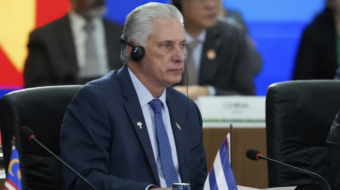Last week the Cuban government announced a bold restructuring of the country’s entire economy. A half a million state jobs will be eliminated, and their occupants will be helped to find work in the private sector. The jobs being eliminated, and the private sector opportunities being opened up, are mostly in services and food production. The Cuban government says the rest of the economy will remain under state control, and there is no intention to return Cuba to capitalism.
The corporate media and especially the right in the United States are using this information to “prove” that socialism has only brought poverty to Cuba.
If that were so, Cuba, the only country in the Latin America-Caribbean region which has had a socialist system for 50 years, should be poorer than countries with otherwise similar characteristics. That is not remotely true.
Let’s look at a measure called annual “per capita gross domestic product.” There are two ways to calculate this important economic measure for various countries: simply the divide the gross domestic product by the population of the country, or adjust it for differences in the cost of living. I prefer the latter, though it is harder to calculate, because it gives a better measure of the actual standard of living in each country. This is usually called “per capita gross domestic product-PPP” (purchasing power parity).
The highest figures for per capita GDP-PPP all apply to the wealthiest capitalist countries. The lowest mostly are found in Africa, plus Afghanistan
In the Latin America-Caribbean area, Cuba is neither in the highest per capita GDP group, nor, remotely, in the lowest. Its estimated per capita GDP-PPP is about $9,500 per year.
The following countries in the region have a higher figure than Cuba (mostly 2008 estimates, and therefore before the current crisis):
Bahamas ($28,600), St. Kitts and Nevis ($19,700), Antigua and Barbuda ($19,000), Barbados ($19,300), Trinidad and Tobago ($18,600), Puerto Rico ($17,800), Chile ($14,900) Argentina ($14,200), Mexico ($14,200), Venezuela ($13,500), Grenada ($13,400), Uruguay ($12,200), Costa Rica ($11,600), Panama ($11,600), St. Lucia ($11,300), St. Vincent and the Grenadines ($10,500), Brazil ($10,100), Dominica ($9,900).
The following countries have lower per capita GDP calculated by the PPP method than does Cuba: Colombia ($8,900), Suriname ($8,900), Belize ($8,600), Peru ($8,400), Dominican Republic ($8,100), Ecuador ($7,500), Jamaica ($7,400), El Salvador ($6,200), Guatemala ($5,200), Bolivia ($4,500), Honduras ($4,400), Paraguay ($4,200), Guyana ($3,900), Nicaragua ($2,900), Haiti ($1,300 before the earthquake).
But the per capital GDP, even with the PPP adjustment, does not really tell us what kind of standard of living exists. For that, we have to look at a thing called the HDI or Human Development Index. The Wikipedia article on this is decent.
This statistic combines a number of quality-of-life measures including life expectancy, health statistics, education and literacy. A perfect score would be 1. The highest current score (2007, before the current crisis) was Norway at 0.971, and the lowest score was Niger (0.340). The HDI figure for the U.S. is 0.956. Cuba comes in at 0.863.
The only countries in the Latin America-Caribbean region that do better than Cuba on the Human Development Index are Barbados (0.878), Argentina (0.863), Chile (0.854), Uruguay (0.840), Costa Rica at (0.38), St.Kitts and Nevis (0.836) and the Bahamas (0.832). All the rest of the countries in the region have much lower HDI figures, with Cuba’s close neighbors the Dominican Republic at 0.729 and Haiti at 0.532 even before the earthquake.
The countries that do worst on these measures include the ones that have been most under the thumb of imperialism and international monopoly capital: Haiti, Honduras, Nicaragua, Guatemala, Bolivia etc. Let us remember that.
None of these countries has had to put up with the 50-year economic blockade to which Cuba has been subjected by the greatest military and economic power on earth, the United States of America. I follow the Cuban practice of calling this a “blockade” and not merely an “embargo” because the United States not only prohibits most kinds of trade with Cuba for its own citizens; it works hard to stop other countries from trading with Cuba as well.
Neither the leaders in Cuba nor the average citizens have ever been satisfied with what they have achieved. They are always looking for new ways of doing things that will improve their economy and the life of their people. But the bourgeois media have a class interest in trying to use Cuba’s problems to prove that not only the Cubans but we in the United States are all doomed to life under capitalism forever.
Putting Cuba’s vital statistics into regional context can be a corrective.










